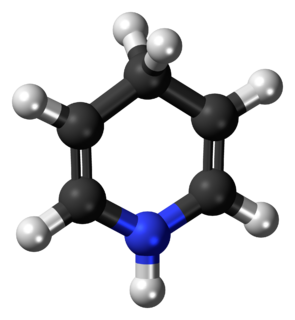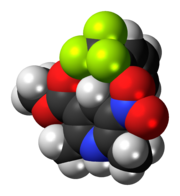An antianginal is a drug used in the treatment of angina pectoris, a symptom of ischaemic heart disease.
Calcium channel blockers (CCB), calcium channel antagonists or calcium antagonists are a group of medications that disrupt the movement of calcium through calcium channels. Calcium channel blockers are used as antihypertensive drugs, i.e., as medications to decrease blood pressure in patients with hypertension. CCBs are particularly effective against large vessel stiffness, one of the common causes of elevated systolic blood pressure in elderly patients. Calcium channel blockers are also frequently used to alter heart rate, to prevent peripheral and cerebral vasospasm, and to reduce chest pain caused by angina pectoris.
An inotrope is an agent that alters the force or energy of muscular contractions. Negatively inotropic agents weaken the force of muscular contractions. Positively inotropic agents increase the strength of muscular contraction.

Diltiazem, sold under the brand name Cardizem among others, is a calcium channel blocker medication used to treat high blood pressure, angina, and certain heart arrhythmias. It may also be used in hyperthyroidism if beta blockers cannot be used. It is taken by mouth or injection into a vein. When given by injection, effects typically begin within a few minutes and last a few hours.
Chronotropic effects are those that change the heart rate.
Myocardial contractility represents the innate ability of the heart muscle (cardiac muscle or myocardium) to contract. The ability to produce changes in force during contraction result from incremental degrees of binding between different types of tissue, that is, between filaments of myosin (thick) and actin (thin) tissue. The degree of binding depends upon the concentration of calcium ions in the cell. Within an in vivo intact heart, the action/response of the sympathetic nervous system is driven by precisely timed releases of a catecholamine, which is a process that determines the concentration of calcium ions in the cytosol of cardiac muscle cells. The factors causing an increase in contractility work by causing an increase in intracellular calcium ions (Ca++) during contraction.

Dihydropyridine (DHP) is a molecule based upon pyridine, and the parent of a class of molecules that have been semi-saturated with two substituents replacing one double bond. They are particularly well known in pharmacology as L-type calcium channel blockers, used in the treatment of hypertension. Compared with certain other L-type calcium channel blockers that have significant action at the heart, they are relatively vascular selective in their mechanism of action in lowering blood pressure.

Lercanidipine is an antihypertensive drug. It belongs to the dihydropyridine class of calcium channel blockers, which work by relaxing and opening the blood vessels allowing the blood to circulate more freely around the body. This lowers the blood pressure and allows the heart to work more efficiently.

Isradipine is a calcium channel blocker of the dihydropyridine class. It is usually prescribed for the treatment of high blood pressure in order to reduce the risk of stroke and heart attack.

Calcium channel, voltage-dependent, L type, alpha 1C subunit is a protein that in humans is encoded by the CACNA1C gene. Cav1.2 is a subunit of L-type voltage-dependent calcium channel.

Calciseptine (CaS) is a natural neurotoxin isolated from the black mamba Dendroaspis p. polylepis venom. This toxin consists of 60 amino acids with four disulfide bonds. Calciseptine specifically blocks L-type calcium channels, but not other voltage-dependent Ca2+ channels such as N-type and T-type channels.
The term dromotropic derives from the Greek word δρόμος drómos, meaning "running", a course, a race. A dromotropic agent is one which affects the conduction speed in the AV node, and subsequently the rate of electrical impulses in the heart.

Multifocal atrial tachycardia (MAT) is an abnormal heart rhythm, specifically a type of supraventricular tachycardia, that is particularly common in older people and is associated with exacerbations of chronic obstructive pulmonary disease (COPD). Normally, the heart rate is controlled by a cluster of cells called the sinoatrial node. When a number of different clusters of cells outside the SA node take over control of the heart rate, and the rate exceeds 100 beats per minute, this is called multifocal atrial tachycardia.

The L-type calcium channel is part of the high-voltage activated family of voltage-dependent calcium channel. "L" stands for long-lasting referring to the length of activation. This channel has four subunits.

Cav1.1 also known as the calcium channel, voltage-dependent, L type, alpha 1S subunit, (CACNA1S), is a protein which in humans is encoded by the CACNA1S gene. It is also known as CACNL1A3 and the dihydropyridine receptor.

Voltage-dependent calcium channel gamma-1 subunit is a protein that in humans is encoded by the CACNG1 gene.

Efonidipine (INN) is a dihydropyridine calcium channel blocker marketed by Shionogi & Co. of Japan. It was launched in 1995, under the brand name Landel (ランデル). The drug blocks both T-type and L-type calcium channels. Drug Controller General of India (DCGI) has approved the use of efonidipine in India. It is launched under the brand name "Efnocar".

Anipamil is a calcium channel blocker, specifically of the phenylalkylamine type. This type is separate from its more common cousin Dihydropyridine. Anipamil is an analog of the more common drug verapamil, which is the most common type of phenylalkylamine style calcium channel blocker. Anipamil has been shown to be a more effective antiarrhythmic medication than verapamil because it does not cause hypertension as seen in verapamil. It is able to do this by bonding to the myocardium tighter then verapamil.

Istaroxime is an investigational drug originally patented and developed by the Italian pharmaceutical company Sigma-Tau. Istaroxime is now under development for treatment of acute decompensated heart failure by CVie Therapeutics. CVie Theraputics is a Taiwanese pharmaceutical company owned by Lee's Pharmaceutical Holdings Limited, that in July 2012 has acquired from Sigma-Tau, the patents and rights on istaroxime, and related compounds. It is still in early-stage development, having been evaluated in phase two clinical trials. Istaroxime is an innovative medication as it is an effective treatment for both systolic and diastolic heart failure. Systolic heart failure is characterized by impaired ventricular emptying, caused by reduced contractility, and diastolic dysfunction is defined by defective ventricular filling, caused by the heart's inability to properly relax between beats. Intracellular calcium fluxes regulate both contraction and relaxation. Cardiac muscle cells from patients with heart failure show smaller amounts of peak calcium in their cytoplasm during contraction, and slower removal., The mishandling of intracellular calcium is often due to problems in the cells’ ability to mediate calcium influx, and sequestration of calcium back in the sarcoplasmic reticulum.,
A calcium channel opener is a type of drug which facilitates ion transmission through calcium channels.















